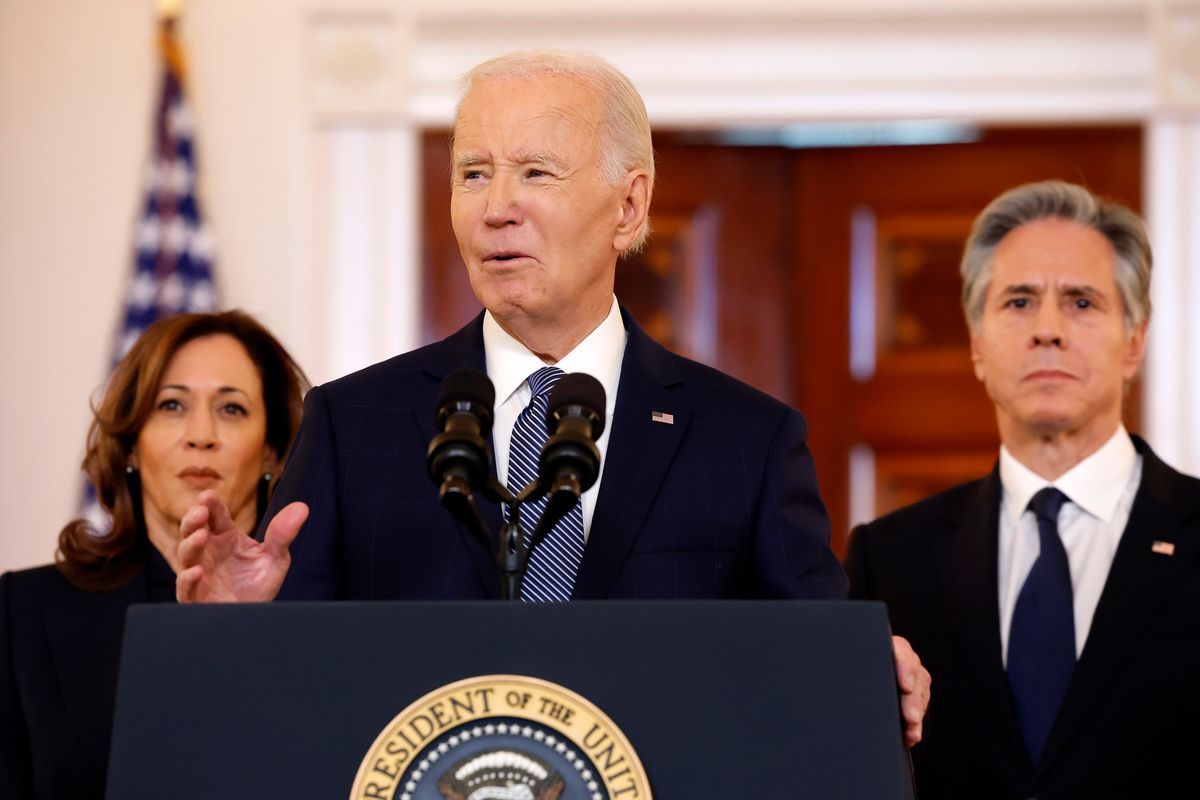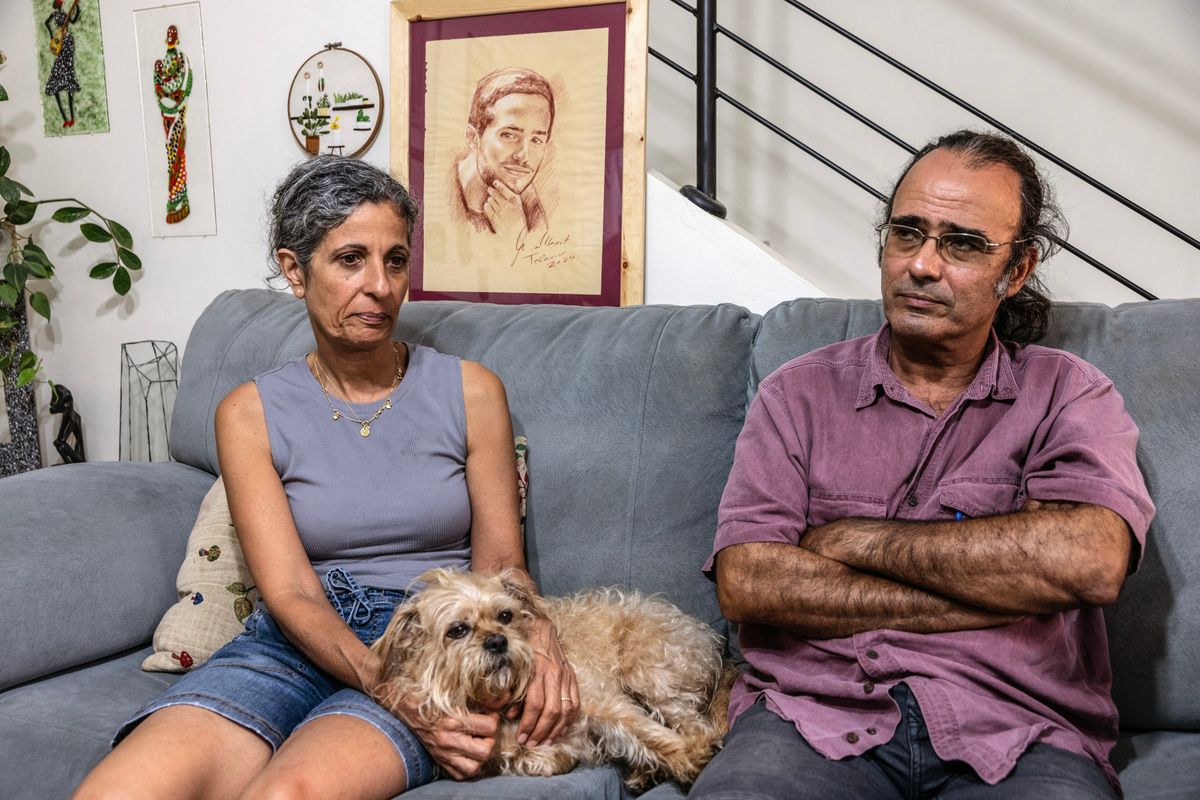Israel, Hamas agree to Gaza ceasefire, raising hopes of a reprieve
President Joe Biden, center, delivers remarks on the recently announced ceasefire deal between Israel and Hamas on Wednesday while joined by Vice President Kamala Harris, left, and Secretary of State Antony Blinken in the Cross Hall of the White House in Washington, D.C. (Anna Moneymaker)
JERUSALEM – After more than a year of painstaking negotiations, Israel and Hamas agreed Wednesday to a ceasefire deal in the Gaza Strip that, if implemented, would see nearly three dozen Israeli hostages reunited with their families and give hungry and displaced Palestinians a reprieve from months of violence.
Israel’s government still needs to formally approve the deal, in a vote officials say will take place Thursday morning. But the agreement could mark a first step toward ending a 15-month war that has destroyed Gaza and divided Israelis.
The truce, mediated by the United States, Egypt and Qatar, would begin on Sunday and cover an initial period of 42 days.
“This is one of the toughest negotiations I’ve ever experienced,” President Joe Biden said Wednesday in remarks from the White House. “And I’m deeply satisfied this day has come … for the sake of the people of Israel and the families waiting in agony, and for the sake of the innocent people in Gaza who suffered unimaginable devastation because of the war.”
Under the first six-week phase of what mediators hope will evolve into a three-stage process for peace, 33 of the 98 remaining Israeli hostages in Gaza – mainly women, children, the elderly and wounded – will be released from Hamas captivity in exchange for hundreds of Palestinians in Israeli detention, in a carefully choreographed sequence that will involve humanitarian groups and coordination between Hamas, Egypt and Israel.
Among the 33 captives slated for release are Americans Keith Siegel and Sagui Dekel-Chen, said a senior administration official, who spoke on the condition of anonymity under rules set by the White House.
Dekel-Chen was wounded in the Hamas attack on Oct. 7, 2023, and Siegel, 64, will be freed because of his age. A third U.S. citizen, Edan Alexander, was abducted near Gaza while serving in the Israeli military and won’t be released until the second phase of the ceasefire.
Hamas agreed to release five female Israeli soldiers in the first phase. The remains of at least four more Americans are also still in Gaza. “We are committed to getting the remains out,” the official said.
Israel will withdraw troops from some parts of Gaza and allow a surge of humanitarian aid into the enclave, where 90% of the population, or 1.9 million people, are displaced in squalid conditions with little food, water or shelter from the cold.
During the first phase, the volume of aid entering Gaza is supposed to reach more than 500 trucks per day, State Department spokesman Matthew Miller said Wednesday – a more than sixfold increase over the average number in December.
But even once the bombs stop falling, steep challenges will remain in getting lifesaving assistance to civilians who need it, including abiding lawlessness in Gaza, destroyed roads and onerous Israeli inspection processes for cargoes entering the territory, aid workers say.
“This is a moment of hope and opportunity, but we should be under no illusions how tough it will still be to get support to survivors,” U.N. Under-Secretary-General for Humanitarian Affairs Tom Fletcher said in a statement. “The stakes could not be higher.”
Israeli forces will remain in a buffer zone along Gaza’s borders, Qatari Prime Minister Mohammed bin Abdulrahman Al Thani said in a news conference in Doha, where negotiators spent the past few days hammering out the deal. After a week, if the truce holds, Palestinian civilians sheltering in southern and central Gaza will be allowed to return to the north, which in recent months has been decimated by intense Israeli bombardment and clashes with Hamas militants.
Since October, Israeli forces have besieged the northernmost part of the enclave, blocking most aid and forcing thousands of residents to evacuate. Israel divided the territory into a north and south with a line of fortified checkpoints known as the Netzarim Corridor just outside Gaza City, only occasionally allowing humanitarians to cross into northern areas.
Negotiations for Phase 2 of the deal – during which the remaining living hostages would be released and Israel would withdraw completely from Gaza – are supposed to begin in the coming weeks. During Phase 3, Hamas would return the bodies of hostages who were killed and the reconstruction of Gaza would get underway.
The deal has offered a glimmer of hope in a conflict that has taken an immense human toll: Israeli attacks have killed more than 46,700 people in Gaza and injured more than 110,200, according to the Gaza Health Ministry, which does not distinguish between civilians and combatants but says the majority of the dead are women and children. Israel estimates that about 1,200 people were killed in Hamas’ Oct. 7, 2023, attack, including more than 300 soldiers. It says 405 soldiers have been killed in its military operation in Gaza.
A war that began with Hamas-led attacks on southern Israel spiraled into a regional conflagration, marked by more than a year of exchanges of fire between Israel and its allies and Iran-aligned groups in Lebanon, Yemen, Iraq and Syria.
There was still much that could go wrong during the deal’s implementation, and Israeli officials have emphasized that so far, it is a temporary pause. The thorniest questions – including who will govern and secure Gaza – remain unresolved, and negotiations over these and other issues are expected to begin later in the process.
Israel’s bombardment of Gaza hasn’t let up: At least 19 people were killed in Israeli airstrikes across the territory on Wednesday night after the ceasefire was announced.
Still, even before mediator Qatar declared that a deal was reached, celebrations broke out in Gaza and among hostage families and supporters in Tel Aviv.
Israeli Prime Minister Benjamin Netanyahu’s office issued a statement shortly after the announcement insisting that some details still needed to be worked out. But President-elect Donald Trump had blasted out the news to the world, writing on his social media platform, Truth Social: “WE HAVE A DEAL FOR THE HOSTAGES IN THE MIDDLE EAST. THEY WILL BE RELEASED SHORTLY. THANK YOU!”
Late Wednesday night, the parties were still arguing over the names of high-profile prisoners to be released under the agreement, according to an official familiar with the matter, who spoke on the condition of anonymity to discuss sensitive talks.
Netanyahu’s cabinet and members of his coalition government must vote on Thursday morning to approve the deal. His far-right allies in government, including Finance Minister Bezalel Smotrich and National Security Minister Itamar Ben Gvir, both slammed the agreement as a bad deal that spares Hamas and threatened to withdraw from Netanyahu’s government.
Still, the prime minister is widely expected to have enough votes to push through the agreement, and Israel’s Supreme Court is expected to dismiss possible legal challenges to the deal.
“This is an important move. This is a necessary move,” Israeli President Isaac Herzog said in televised remarks Wednesday night, urging the government to make the ceasefire official. “There is no greater moral, human, Jewish, or Israeli obligation than to bring our sons and daughters back to us – whether to recover at home, or to be laid to rest.”
Leaders from mediating countries appeared to dismiss the procedural steps in Israel as mere formalities. Qatar’s Mohammed, Biden and Egyptian President Abdel Fatah El-Sisi each declared victory after months of stop-and-start negotiations that repeatedly saw negotiators and intelligence chiefs huddle in Middle Eastern capitals, only to return home empty-handed.
“There was no other way for this war to end than with a hostage deal,” Biden said Wednesday. “Too many innocent people have died. Too many communities have been destroyed.”
The mediators, at least for now, overcame the herculean task of reconciling the diametrically opposed positions of Israel and Hamas. Israel wanted to continue the fighting after a temporary pause and hostage-for-prisoner exchange, while Hamas insisted on a permanent end to the war before it would surrender any captives.
But pressure on both parties pushed them to close the gap. Netanyahu was under fire from hostage families and those who lost loved ones in the war. He was also in potential legal peril abroad, after the International Criminal Court issued an arrest warrant accusing him of war crimes and crimes against humanity.
In Gaza, Hamas was severely weakened after Israel killed its top leaders and kneecapped regional allies. Residents grew increasingly angry as they struggled to survive the punishing campaign Israel launched in response to the Hamas attacks.
In the end, the deal agreed to Wednesday aligns to a large extent with the phased approach Biden proposed in May: An initial pause in hostilities and release of hostages is intended to lead to “sustainable calm,” according to a joint statement by Qatar, Egypt and the United States. Those three countries are meant to serve as guarantors of the deal, and Mohammed said a monitoring body would be established in Cairo.
Biden and Trump each claimed credit for a diplomatic achievement closed through rare foreign-policy collaboration between the outgoing and incoming administrations. As Biden officials carried out the formal diplomacy, Steve Witkoff, Trump’s special envoy to the Middle East, met with Netanyahu over the weekend to pressure the Israeli prime minister to agree to a deal before Trump’s inauguration.
“This EPIC ceasefire agreement could have only happened as a result of our Historic Victory in November, as it signaled to the entire World that my Administration would seek Peace and negotiate deals to ensure the safety of all Americans, and our Allies,” Trump wrote on Truth Social.
Biden said “this deal was developed and negotiated under my administration” but that his officials had been speaking “as one team” with their soon-to-be successors in recent days.
Hamas leader Khalil al-Hayya hailed the ceasefire as a triumph for the militant group.
“Today we prove that the occupation will never defeat our people and their resistance,” he said in a statement.
Hospitals in Israel are preparing to receive hostages who may be malnourished, injured or ill – and will certainly be traumatized, Israeli media reported.
In Tel Aviv, where thousands have gathered for months each Saturday night to protest the government’s failure to bring all of the hostages home sooner, crowds beat drums and chanted.
“I hope it will not just be a ceasefire but a stop to the war,” said Benjamin Terem, 65, from Tel Aviv. “We cannot stay in this situation.”
In Gaza, 20-year-old Farah Hathout said she was displaced nine times throughout the war. She woke up where she is sheltering in Nuseirat, a refugee camp in central Gaza, to check the news.
“Is it real? Have they signed?” she said she asked herself.
“I pray it goes through,” said Hathout, who was in tears. “May God compensate us for what we experienced.”
- – -
DeYoung reported from Washington, Shih from Jerusalem, Balousha from Toronto and Mahfouz from Cairo. Miriam Berger and Lior Soroka in Tel Aviv, Mohamad El Chamaa in Beirut, and Hajar Harb in London contributed to this report.

